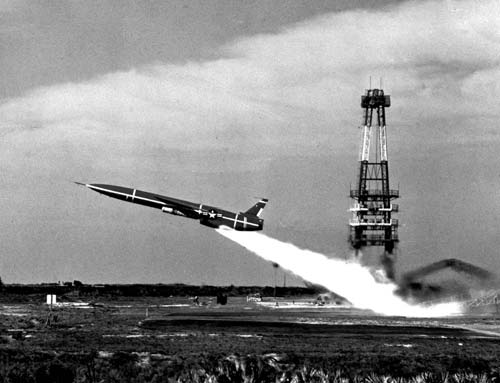guided missiles, postwar development

The SM-62 Snark surface-to-surface cruise missile.
In the decade after World War II, the United States government, persuaded by the conservative arm of the military, decided that the nation's main deterrent force should consist of manned intercontinental bombers supplemented by air-breathing guided missiles evolved from the German V-1. Despite the early postwar warnings of General Henry H. Arnold and others, who argued for the immediate development of long-range ballistic missiles capable of carrying atomic warheads, this approach was deemed too costly and difficult at the time. Just after the war, former NACA (National Advisory Committee for Aeronautics) Chairman Vannevar Bush, then Director of the Office of Scientific Research and Development, expressed the prevailing mood in a testimony before a Congressional committee: "There has been a great deal said about a 3,000-meter high-angle rocket. In my opinion, such a thing is impossible today and will be impossible for many years..." Thus, in the late 1940s and early '50s, the United States focused on developing relatively small guided missiles for air-to-air, air-to-surface, and surface-to-air interception and as tactical surface-to-surface weapons. The Soviets, by contrast, threw themselves into building huge ballistic missiles capable of carrying the heavy nuclear weapons of that period over thousands of miles – a decision which gave them a long-lasting lead in space exploration.
Interservice rivalry led the Army, Navy, and Air Force to pursue essentially separate missile-development programs. The great success of the Air Corps during the war had conditioned it to think in terms of winged vehicles. As a result, the Air Force put more effort at first into two subsonic missile programs, Snark and Matador, than the supersonic, long-ranged Atlas. Later came the Navaho; but by this time it was clear that such weapons were not effective compared to longer-range ballistic missiles.
While the Air Force concentrated on relatively small guided missiles, the Army, having inherited a stockpile of V-2s and a team of German rocket specialists, naturally chose to build on this ready-made pool of hardware and expertise. But as the supply of Nazi missiles diminished and it was evident that rocket technology had moved beyond the V-2 stage, the Army initiated the Hermes program and, later, the development of the Redstone missile based on the liquid-propellant engine of the Navaho.
By the early 1950s, intelligence revealed that the Soviets were evolving long-range nuclear ballistic missiles that posed a serious threat to the West. In response, priority in the United States switched from the development of guided missiles to intermediate-range and intercontinental ballistic missile programs, including the Jupiter, Atlas, and Thor.


